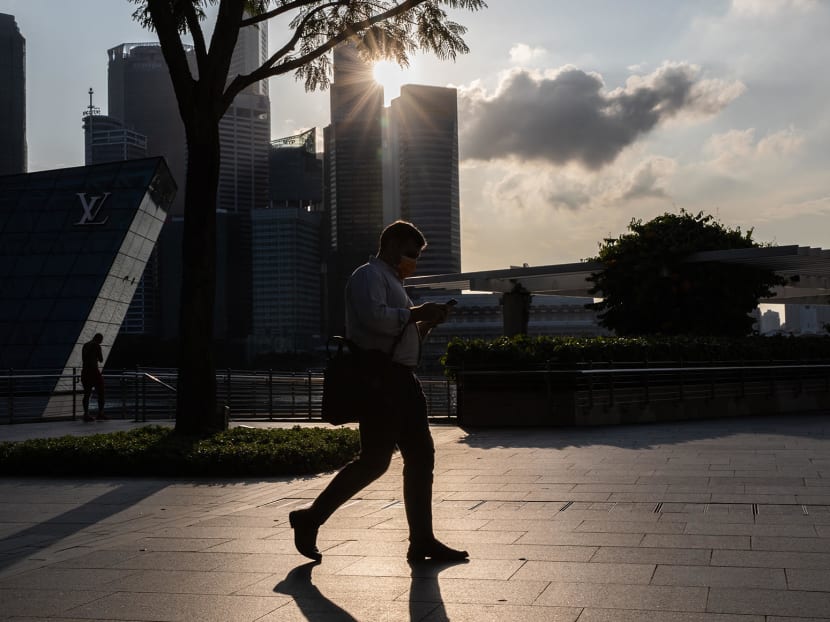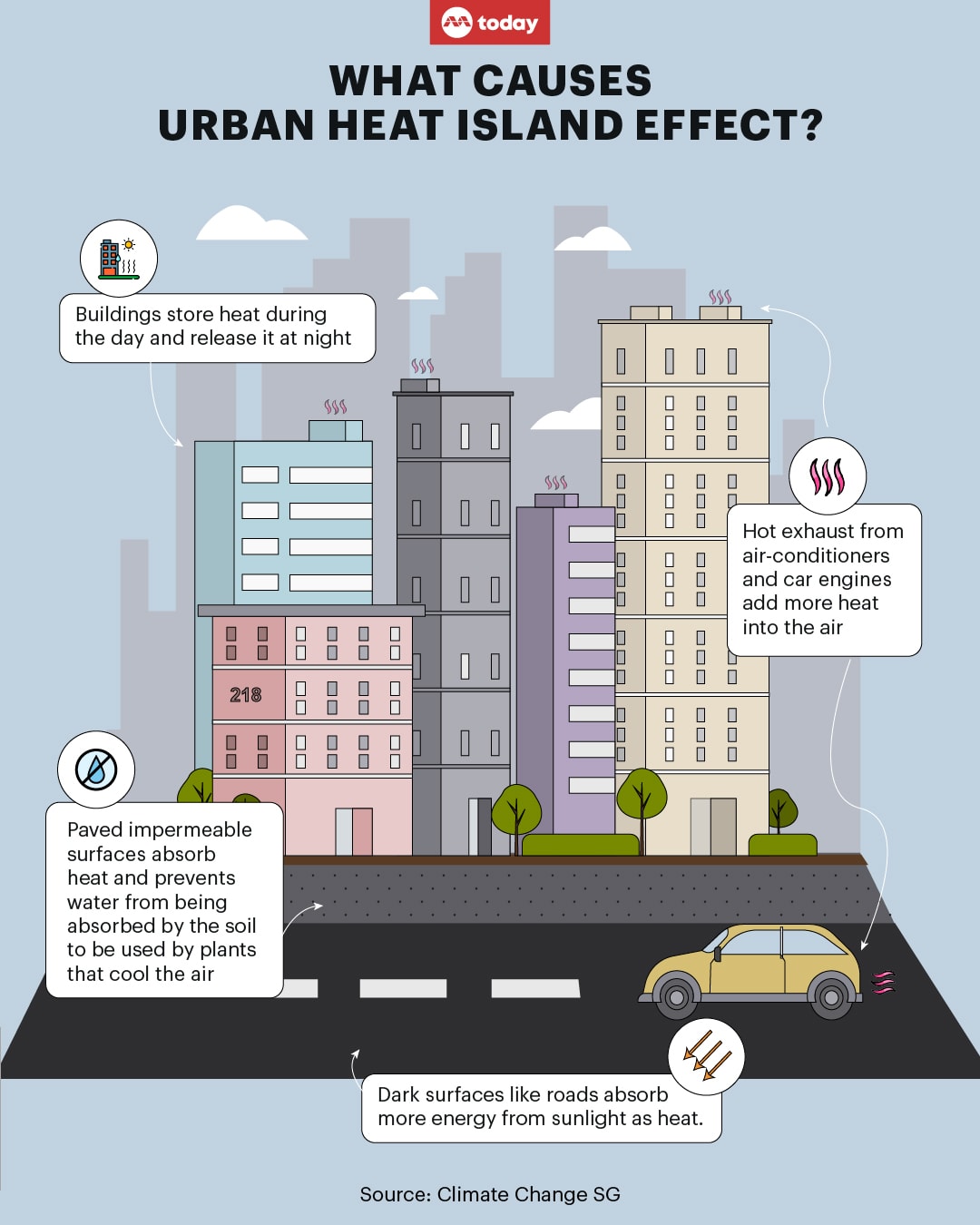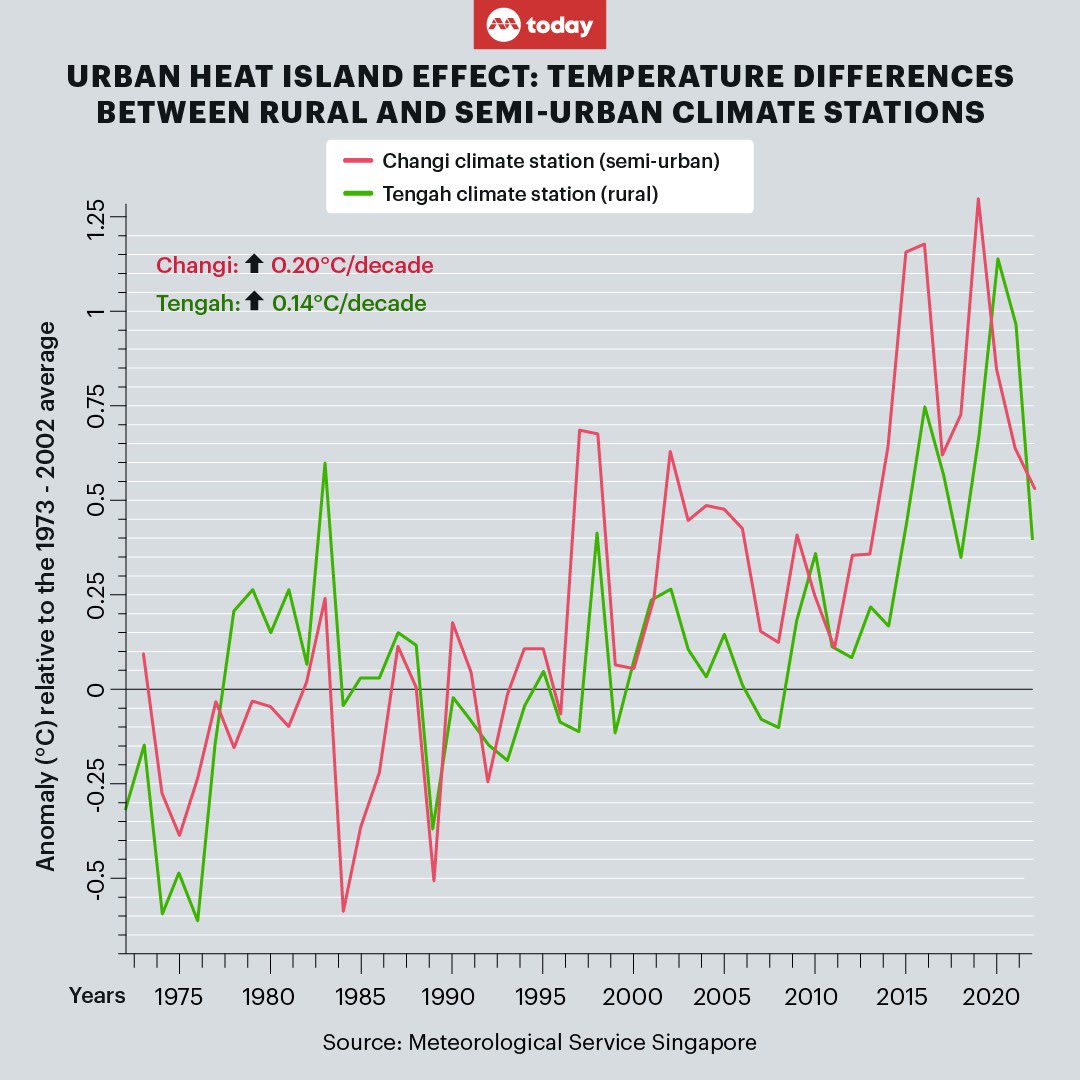Data from 50 years shows rising temperatures in S'pore partly due to its urban environment: Met Service report
SINGAPORE — Records spanning 50 years suggest that Singapore's man-made urban environment is one factor contributing to the trend of warmer average temperatures here, especially at night.

The authorities have launched a "heat stress advisory" in Singapore as temperatures here and around the world continue to rise amid climate change.
- Temperature records spanning 50 years suggest Singapore's man-made environment is one factor contributing to a trend of warming temperatures, especially at night
- A report by the Meteorological Service Singapore said comparisons of historical temperatures at relatively built-up Changi with those at mainly rural Tengah supported the theory
- A climate expert told TODAY that such data is important as cities like Singapore have to contend with a phenomenon called urban heat island effect, on top of global climate change
- MSS' report also showed that the 10-year period until 2022 was the warmest decade on record
- 2022 was also among the wettest years since 1980
SINGAPORE — Records spanning 50 years suggest that Singapore's man-made urban environment is one factor contributing to the trend of warmer average temperatures here, especially at night.
A Meteorological Service Singapore (Met Service) report published on Thursday (March 23) found evidence to support the "urban heat island effect" by comparing long-term temperature trends in a relatively green part of the island with those in a fairly built-up area.
This effect is a phenomenon where air temperatures in built-up areas are significantly warmer than those in greener areas. The word "island" refers to an area covered by urbanisation and not a geographical island.
The night-time minimum temperatures in semi-urban Changi have risen more rapidly than those at mainly rural Tengah over the period from 1973 to 2022, the report found.
It noted that the heat island effect was just one factor contributing to the trend, along with other factors such as global climate change.
Previous editions of the Annual Climate Assessment Singapore published by the Met Service have made passing reference to the urban heat island effect.
However, the 2022 edition published on Thursday was the first to include a subsection specifically on the urban heat island effect.
The 2022 report also outlined weather extremities observed during the year.WHY IT MATTERS
Singapore, like all cities, suffers from the urban heat island effect, said Professor Benjamin Horton, director of the Earth Observatory of Singapore.
He told TODAY that this was something that cities have to grapple with while at the same time contending with the separate effects of climate change.
“It may become so severe that those elderly or young or infirm cannot be outside at certain parts of the day,” said Prof Horton.
Publishing such data can help the community be more aware of the problem as the nation collectively considers how it would like to redesign its development to deal with these climate and environmental issues, he said.

CHANGI WARMING UP MORE RAPIDLY THAN TENGAH
Between 1973 and 2022, the night-time minimum temperatures at Changi have warmed more rapidly at a rate of 0.20°C per decade, than in the Tengah area, where they rose at 0.14°C per decade.
The Changi weather station, sited near more developed residential areas and close to the airport runway, is considered representative of a semi-urban environment.
The Tengah station, on the other hand, is close to the Tengah River, surrounded by forested areas, and is representative of a rural area, said the report.
The difference in upward trends between the two suggests evidence of the urban heat island effect contributing to Singapore’s overall long-term temperature trend, said the report.
The report, however, noted that the extent to which the effect is felt at different specific locations across Singapore would depend on the degree of human activity as well as on environmental and meteorological factors.
“Nonetheless, the noticeable difference between Changi’s and Tengah’s long-term temperature records highlights the urban heat island contribution to Singapore’s long-term warming trend,” said the report.
“Nonetheless, the noticeable difference between Changi’s and Tengah’s long-term temperature records highlights the urban heat island contribution to Singapore’s long-term warming trend.Met Service Annual Climate Assessment Singapore”
“These materials have a property that they absorb incoming solar radiation, and then they gradually release them. So you have an urban heat island effect,” said the professor, who added that the effect is most felt during the latter part of the day.
“The difference in temperature between, let's say, the western side of the island, where there is far more abundance of trees and open water to the Central Business District, can be as much as three degrees centigrade,” he added.
“The difference in temperature between, let's say, the western side of the island, where there is far more abundance of trees and open water to the Central Business District, can be as much as three degrees centigrade.Professor Benjamin Horton, director of the Earth Observatory of Singapore”
He said that embarking on various measures and campaigns to make the city more resilient to the urban heat island effect, such as by planting more trees and opening up fresh water areas in the city, will also reap other benefits such as improving biodiversity and improving carbon retention.
WARMEST DECADE ON RECORD
The report said 2022 was the 10th warmest year since 1929, when Singapore temperature records began, with an annual mean temperature of 27.9°C. This was a six-way tie with 2021, 2018, 2014, 2009 and 2004.
Temperatures in the months of January and May last year were notably warmer than their respective long-term average.
On the other hand, June and October were 0.6°C and 0.3°C cooler than their respective long-term monthly mean temperatures, making them the coolest June and October in the past 10 years.
The 10-year period from 2013 to 2022 was Singapore’s warmest decade on record, with a mean temperature of 28.01°C over the period, said the report.
This was 0.04°C higher than the previous record for the preceding decade between 2012 and 2021.
SIXTH WETTEST YEAR SINCE 1980
According to the report, 2022 was the sixth wettest year since 1980, with an annual total rainfall of 3012mm.
This was 18.5 per cent above the long-term annual total of 2534.3mm.
In comparison, the wettest year recorded in that period was in 2007, when more than 3200mm of rainfall was recorded.
Other than January, July and December, the remaining nine months of 2022 recorded above-average monthly total rainfall.
The Changi climate station in particular saw 210 rain days in 2022, the third highest number of annual raindays on record. The highest number of days, 222, was recorded in 1973 and 1927.
A rainday is defined as a day with at least 0.2mm rainfall recorded at a rainfall station.
NOTABLE WEATHER EVENTS
The report outlined three notable weather events in 2022:
1. WETTEST MARCH IN 13 YEARS
- 2022 saw the wettest March since 2009, with most parts of the island receiving above-average rainfall
- This was mainly triggered by solar heating of land areas coupled with convergence of winds over the island, said the report
- The highest daily total rainfall of 134.2mm was recorded at Jurong West on March 7, making it the second wettest March day in the last 10 years
2. NEW TEMPERATURE RECORDS IN MAY
- The highest daily maximum temperature of 36.7°C was recorded on May 13 at Admiralty
- This makes the day the warmest in May on record, surpassing the previous highs of 36.5°C on May 16, 2010 and May 3, 2016
- Daily maximum temperatures exceeded 34.0°C on 22 days of the month, and surpassed 35.0°C on 13 days
3. WETTEST OCTOBER IN FOUR DECADES
- Average rainfall for the month was 412.0mm, making October 2022 the wettest October in the past four decades
- Kent Ridge station reported more than three times its long-term average rainfall
- Over at Changi, 27 rain days were recorded, exceeding the previous record of 23 days for October









